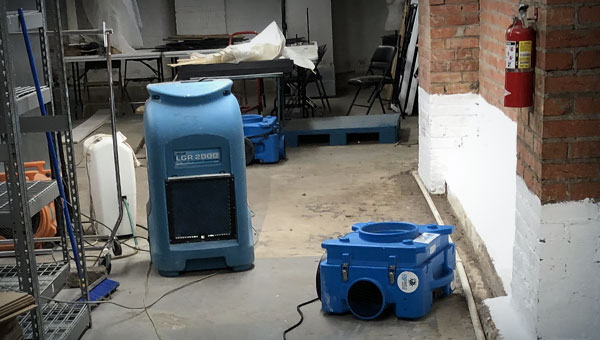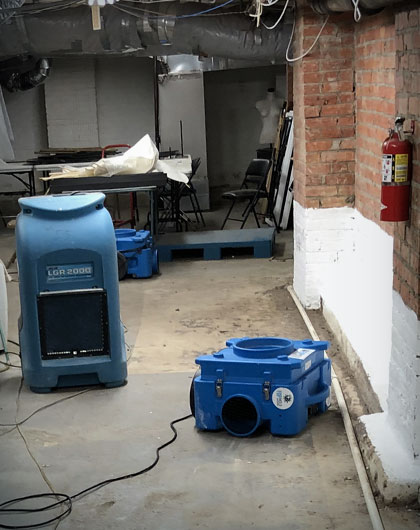
If you've ever dealt with mold in your home, you've probably asked yourself: does a dehumidifier kill mold? It's a common question and one that deserves a clear, science-backed answer.
The short answer is no. A dehumidifier does not kill mold spores or remove existing mold colonies. What it does is reduce the moisture levels in the air, which helps prevent mold from growing in the first place.
Mold thrives in damp, humid environments. When indoor humidity climbs above 60%, mold spores can activate and spread quickly, especially in basements, bathrooms, crawl spaces, and poorly ventilated rooms. A dehumidifier helps by pulling excess moisture from the air, making it harder for mold to survive.
But here's the catch: if mold is already present, a dehumidifier won't make it disappear. It won't clean mold off walls, remove that musty odor, or stop spores from lingering in your HVAC system. That's where professional mold remediation comes in.
Many homeowners mistakenly believe that running a dehumidifier is enough to solve a mold problem. This misconception can lead to recurring mold outbreaks, hidden structural damage, and even health issues like allergies or respiratory irritation.
Mold doesn't need a flood to grow, it just needs elevated indoor humidity and time. When moisture lingers in the air, especially in places like basements, bathrooms, or behind walls, mold spores activate and spread fast.
Even after cleaning visible mold, it often returns. That's because moisture problems weren't fully resolved, or mold spores remained hidden in porous materials like drywall or insulation and weren't properly removed.
A dehumidifier helps by lowering humidity, but it doesn't remove mold from walls, eliminate spores in the air, or fix the root cause of water intrusion. That's why mold often reappears and why assistance from a professional mold remediation company is the only long-term solution.

A dehumidifier's primary job is to remove excess moisture from the air. It draws in humid air, cools it to condense the water vapor, and then releases drier air back into the room. This process helps maintain indoor humidity at safe levels, which are typically between 40% and 50%.
By reducing humidity, a dehumidifier makes your home less hospitable to mold. Mold spores need moisture to grow, and without it, they stay dormant. That's why humidity control is one of the most effective ways to prevent mold growth indoors.
Dehumidifiers are especially useful in high-risk areas like basements, crawl spaces, laundry rooms, and bathrooms. These spaces often have poor ventilation and are prone to condensation, making them ideal environments for mold to thrive.
In addition to mold prevention, dehumidifiers can improve indoor air quality. They help reduce allergens like dust mites and mildew, and they can make your home feel cooler and more comfortable, especially during humid seasons.
However, it's important to understand that a dehumidifier is a preventative tool, not a mold removal solution. It works best when used after remediation or in homes that are mold-free but prone to moisture buildup.
A dehumidifier does not kill mold. It doesn't destroy spores, remove colonies, or clean contaminated materials. Its function is to control humidity, not to eliminate mold that's already active.
Mold that's visible on walls, ceilings, or furniture must be physically removed. This often requires professional cleaning, disinfection, and in some cases, replacing porous materials like drywall or carpet. A dehumidifier alone cannot perform this task.
It's also important to understand the difference between dormant mold and dead mold. When humidity drops, mold may stop growing, but it doesn't die. It simply becomes inactive. Dormant mold can reactivate quickly when moisture returns, especially in hidden areas like behind walls or under flooring.
Some homeowners ask, "Can a dehumidifier remove the mold smell?" The answer is no. That musty odor comes from microbial gases released by active mold. Until the source is removed, the smell will remain even if the air feels drier.
In short, a dehumidifier is a preventative tool, not a mold removal solution. It's most effective when used after remediation, to keep moisture levels low and prevent mold from returning.
This is one of the most widespread misconceptions. A dehumidifier does not kill mold spores or remove existing colonies. It only reduces the moisture that mold needs to grow. If mold is already present, it must be physically removed - often by professionals.
While a dehumidifier can reduce the damp, humid conditions that contribute to musty odors, it won't eliminate the smell if mold is still active. That odor comes from microbial gases released by mold colonies. Until the source is removed, the smell will linger.
A dehumidifier helps prevent mold recurrence, but it's not a permanent fix. If the root cause of moisture, like a leak, poor ventilation, or water damage isn't addressed, mold can return even in a drier environment.
This myth has some truth, but only if the unit is poorly maintained. If a dehumidifier's filter or water reservoir isn't cleaned regularly, it can become a breeding ground for mold and bacteria. Proper maintenance is essential to avoid this risk.
Not all mold problems can be solved with a dehumidifier or surface cleaning. If you notice any of the following signs, it's time to consider professional mold remediation.
If one or more of these signs are present, delaying action can lead to structural damage and health risks. A professional inspection ensures the problem is identified, contained, and fully resolved.
A dehumidifier is one of the most practical tools for preventing mold growth, but only when used correctly. Many homeowners run their units without optimizing placement, settings, or maintenance, which limits their effectiveness and may even create new moisture issues.
To get the most out of your dehumidifier and ensure it supports long-term mold prevention, follow these best practices:
Keep indoor humidity between 40% and 50%. This range is ideal for comfort and mold prevention. Anything above 60% increases the risk of mold activation.
Position the unit in areas prone to moisture buildup, such as basements, bathrooms, laundry rooms, or near HVAC systems. Avoid placing it flush against walls or furniture to allow for proper airflow.
Use the dehumidifier regularly, especially during humid seasons or after water-related incidents. Many modern units include built-in hygrometers or timers to automate operation based on real-time humidity levels.
Standing water in the reservoir can become a breeding ground for bacteria and mold. Empty the tank daily in high-humidity conditions and clean it weekly with a mild disinfectant.
Dirty filters reduce airflow and may circulate mold spores. Clean or replace filters according to the manufacturer's instructions. Also, inspect the coils periodically for dust or mold buildup.
If you notice water pooling around the unit or condensation forming on nearby surfaces, check for drainage issues or incorrect settings. A malfunctioning dehumidifier can worsen moisture problems instead of solving them.
Even the best dehumidifier won't prevent mold if it's used incorrectly. Poor placement, neglected maintenance, or inconsistent operation can allow moisture to linger, giving mold the opportunity to grow unnoticed. When used properly, however, a dehumidifier becomes a powerful ally in maintaining a dry, mold-resistant indoor environment.
If you're relying on a dehumidifier alone to fight mold, you're only addressing part of the problem. Mold doesn't just grow - it hides, spreads, and compromises your home's air quality and structure.
At FDP Mold Remediation, we don't guess, we inspect, identify, and eliminate mold at the source. Whether you're dealing with visible growth, hidden moisture, or recurring mold issues, our certified mold specialists are ready to help.
Don't wait for mold to return.
Schedule your professional mold inspection today and take the first step toward a cleaner, safer, and healthier home.
Call us or book online today - fast response, honest pricing, and guaranteed results.
No. A dehumidifier cannot remove black mold or any other type of mold. It only reduces humidity, which helps prevent mold from growing. Existing mold must be physically removed through professional remediation.
Run your dehumidifier as long as indoor humidity stays above 50%. In high-risk areas like basements or during humid seasons, continuous operation may be necessary. Use a hygrometer to monitor levels.
Not entirely. A dehumidifier may reduce the intensity of musty odors by drying the air, but it won't eliminate the smell if mold is still present. The odor will persist until the mold is removed.
Only if the mold was fully removed and the source of moisture was fixed. A dehumidifier helps prevent recurrence, but it's not a standalone solution. Structural repairs and proper ventilation are also essential.
They serve different purposes. A dehumidifier controls moisture, which prevents mold. An air purifier with a HEPA filter can help reduce airborne mold spores. For best results, use both in combination, especially after remediation.



